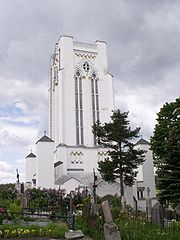
Šiluva
Encyclopedia


Lithuania
Lithuania , officially the Republic of Lithuania is a country in Northern Europe, the biggest of the three Baltic states. It is situated along the southeastern shore of the Baltic Sea, whereby to the west lie Sweden and Denmark...
. It is located in the region of Samogitia
Regions of Lithuania
Lithuania can be divided into historical and cultural regions . The exact borders are not fully clear, as the regions are not official political or administrative units. They are delimited by culture, such as country traditions, traditional lifestyle, songs, tales, etc. To some extent regions...
.
Šiluva was first mentioned in 1457 in relation to the building of the Church of the Nativity of the Blessed Virgin Mary and the Apostles Saint Peter
Saint Peter
Saint Peter or Simon Peter was an early Christian leader, who is featured prominently in the New Testament Gospels and the Acts of the Apostles. The son of John or of Jonah and from the village of Bethsaida in the province of Galilee, his brother Andrew was also an apostle...
and Saint Bartholomew by the Lithuanian noble Petras Gedgaudas. Later the Feast of the Nativity of the Blessed Virgin Mary attracted huge numbers of the faithful to Šiluva, some from as far away of what later became Protestant Prussia
Prussia
Prussia was a German kingdom and historic state originating out of the Duchy of Prussia and the Margraviate of Brandenburg. For centuries, the House of Hohenzollern ruled Prussia, successfully expanding its size by way of an unusually well-organized and effective army. Prussia shaped the history...
.
With the advent of the Reformation
Protestant Reformation
The Protestant Reformation was a 16th-century split within Western Christianity initiated by Martin Luther, John Calvin and other early Protestants. The efforts of the self-described "reformers", who objected to the doctrines, rituals and ecclesiastical structure of the Roman Catholic Church, led...
in 16th century Lithuania, many of the inhabitants of the Šiluva region converted to Calvinism. This caused the church to eventually be ransacked and closed around 1569. The last parish priest, John Holubka, buried the remaining church valuables and legal documents and deeds in an iron box near the vandalized church.
Subsequent attempts by the Catholics to regain the property through legal proceedings against the Calvinists were hindered by the fact that the exact location of the documents pertaining to the church were unknown. Some Catholics believed that the Blessed Virgin Mary miraculously intervened in the matter by appearing at the church and holding the baby Jesus in her arms and weeping bitterly. The founding documents of the Catholic Church were found shortly after the apparition, and in 1622 the Catholics reclaimed the church. The famous Feast of the Nativity of the Blessed Virgin Mary resumed in a small wooden church on the site of the apparition, and the icon
Icon
An icon is a religious work of art, most commonly a painting, from Eastern Christianity and in certain Eastern Catholic churches...
of the Blessed Virgin Mary with the Divine Child became renowned as a source for miracles. The current-day Basilica of the Nativity of the Blessed Virgin Mary was erected on the site in 1786.
The devotion to Our Lady of Šiluva was suppressed once again during the partition of Lithuania
Russian Empire
The Russian Empire was a state that existed from 1721 until the Russian Revolution of 1917. It was the successor to the Tsardom of Russia and the predecessor of the Soviet Union...
since the event had become a venue for sharing Lithuanian religious and secular books that were smuggled in from Prussia – in spite of a Tsarist ban of any Lithuanian publications in Latin characters. Following the restitution of Lithuania’s independence in 1918, the celebration in Šiluva was reinstated and took on special significance. After the Soviet occupation of Lithuania in 1940, a policy against popular religious traditions was implemented. The Soviet regime failed to completely suppress the Feast of the Nativity of the Blessed Virgin Mary although the KGB
KGB
The KGB was the commonly used acronym for the . It was the national security agency of the Soviet Union from 1954 until 1991, and was the premier internal security, intelligence, and secret police organization during that time.The State Security Agency of the Republic of Belarus currently uses the...
routinely sabotaged the pilgrimages. An example of the Soviet interference occurred during the pilgrimage in 1979, when the government blocked all of the roads to Šiluva under the pretext that an epidemic of swine fever was rampant in the vicinity.
Throughout its turbulent history, Šiluva has remained the spiritual center for the Catholic faithful from many parts of Lithuania. The Feast of Šiluva has experienced a tremendous revival following the reestablishment of independence in 1990. Pope John Paul II
Pope John Paul II
Blessed Pope John Paul II , born Karol Józef Wojtyła , reigned as Pope of the Catholic Church and Sovereign of Vatican City from 16 October 1978 until his death on 2 April 2005, at of age. His was the second-longest documented pontificate, which lasted ; only Pope Pius IX ...
made a special pilgrimage to pray at the National Shrine of Our Lady in Šiluva, during his visit to Lithuania in 1993. On the tenth anniversary of the Pope’s visit, a new facility for pilgrims and candidate seminarians was blessed by Archbishop of Kaunas
Roman Catholic Archdiocese of Kaunas
The Roman Catholic Metropolitan Archdiocese of Kaunas is an ecclesiastical territory or diocese of the Roman Catholic Church in Lithuania. It is based in Kaunas, the second-largest city in Lithuania. It was established as the Diocese of Samogitia in 1417 with a seat in Medininkai according to...
Sigitas Tamkevičius
Sigitas Tamkevičius
Sigitas Tamkevičius is a Lithuanian archbishop of the Roman Catholic Church. He currently serves as Archbishop of Kaunas....
and named The John Paul II Home .

